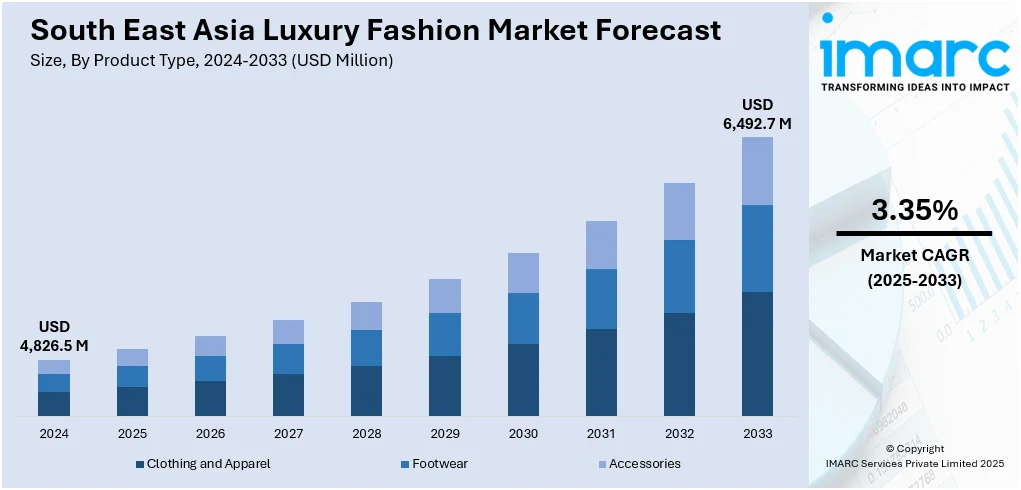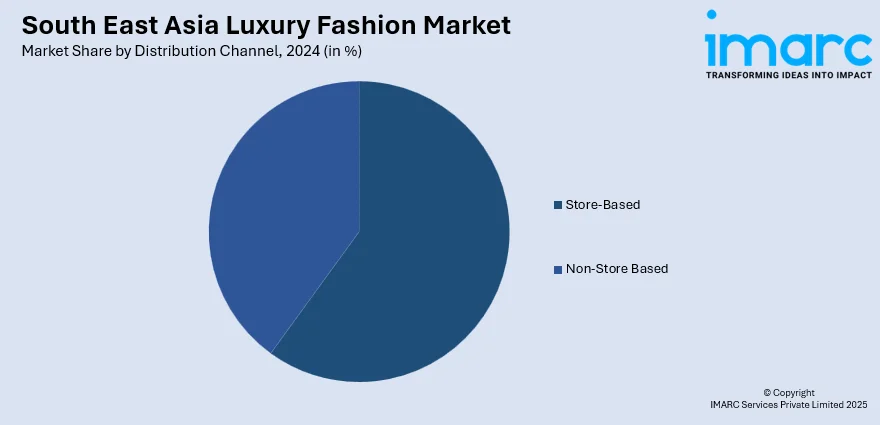
South East Asia Luxury Fashion Market Size, Share, Trends and Forecast by Product Type, Distribution Channel, End User, and Country, 2025-2033
Market Overview:
South East Asia luxury fashion market size reached USD 4,826.5 Million in 2024. Looking forward, IMARC Group expects the market to reach USD 6,492.7 Million by 2033, exhibiting a growth rate (CAGR) of 3.35% during 2025-2033. The increasing shifts in fashion trends, lifestyle choices, and cultural influences that can impact the demand for luxury fashion items, are driving the market.
|
Report Attribute
|
Key Statistics
|
|---|---|
|
Base Year
|
2024 |
|
Forecast Years
|
2025-2033
|
|
Historical Years
|
2019-2024
|
| Market Size in 2024 | USD 4,826.5 Million |
| Market Forecast in 2033 | USD 6,492.7 Million |
| Market Growth Rate (2025-2033) | 3.35% |
Luxury fashion transcends mere attire, embodying a narrative of opulence, craftsmanship, and exclusivity. It goes beyond clothing, transforming garments into symbols of status, artistry, and impeccable taste. Renowned luxury fashion houses meticulously curate collections, employing master artisans to weave fabrics and stitch details that epitomize sartorial excellence. These brands often have storied histories rooted in a commitment to elegance and innovation. A luxury fashion piece is more than a garment; it is a statement, an expression of individuality, and an investment in timeless style. From iconic logos to signature designs, these items are recognized as emblems of sophistication. In the realm of luxury fashion, each creation is a fusion of creativity and precision, inviting individuals to embrace a lifestyle that seamlessly melds aesthetics with the finest materials. Whether on the runway or adorning discerning fashion enthusiasts, luxury fashion remains an enduring celebration of artistry and refinement.

To get more information on this market, Request Sample
South East Asia Luxury Fashion Market Trends:
The luxury fashion market in South East Asia is flourishing due to several key drivers. Firstly, a surge in regional disposable income has elevated consumer spending on high-end fashion items. Consequently, as incomes rise, so does the demand for exclusive, premium brands. Additionally, the growing influence of social media plays a pivotal role in shaping consumer perceptions and preferences. Fashion influencers and celebrities often showcase luxury items, creating aspirational desires among their followers. Moreover, the evolving consumer mindset towards sustainability has prompted luxury brands to incorporate eco-friendly practices, aligning with the increasing demand for ethically produced goods. Furthermore, the proliferation of e-commerce has expanded the reach of luxury fashion, enabling consumers to access and purchase premium products at their convenience. In tandem, innovative marketing strategies, such as limited editions and collaborations, contribute to the exclusivity and desirability of luxury items. Collectively, these interconnected factors continue to propel the thriving momentum of the luxury fashion market in South East Asia, creating a dynamic landscape shaped by evolving consumer trends and economic shifts.
South East Asia Luxury Fashion Market Segmentation:
IMARC Group provides an analysis of the key trends in each segment of the market, along with forecasts at the regional and country levels for 2025-2033. Our report has categorized the market based on product type, distribution channel, and end user.
Product Type Insights:
- Clothing and Apparel
- Jackets and Coats
- Skirts
- Shirts and T-Shirts
- Dresses
- Trousers and Shorts
- Denim
- Underwear and Lingerie
- Others
- Footwear
- Accessories
- Gems and Jewellery
- Belts
- Bags
- Watches
The report has provided a detailed breakup and analysis of the market based on the product type. This includes clothing and apparel (jackets and coats, skirts, shirts and t-shirts, dresses, trousers and shorts, denim, underwear and lingerie, and others), footwear, and accessories (gems and jewellery, belts, bags, and watches).
Distribution Channel Insights:

- Store-Based
- Non-Store Based
A detailed breakup and analysis of the market based on the distribution channel have also been provided in the report. This includes store-based and non-store based.
End User Insights:
- Men
- Women
- Unisex
The report has provided a detailed breakup and analysis of the market based on the end user. This includes men, women, and unisex.
Country Insights:
- Indonesia
- Thailand
- Singapore
- Philippines
- Vietnam
- Malaysia
- Others
The report has also provided a comprehensive analysis of all the major regional markets, which include Indonesia, Thailand, Singapore, Philippines, Vietnam, Malaysia, and Others.
Competitive Landscape:
The market research report has also provided a comprehensive analysis of the competitive landscape in the market. Competitive analysis such as market structure, key player positioning, top winning strategies, competitive dashboard, and company evaluation quadrant has been covered in the report. Also, detailed profiles of all major companies have been provided.
South East Asia Luxury Fashion Market Report Coverage:
| Report Features | Details |
|---|---|
| Base Year of the Analysis | 2024 |
| Historical Period | 2019-2024 |
| Forecast Period | 2025-2033 |
| Units | Million USD |
| Scope of the Report | Exploration of Historical and Forecast Trends, Industry Catalysts and Challenges, Segment-Wise Historical and Predictive Market Assessment:
|
| Product Types Covered |
|
| Distribution Channels Covered | Store-Based, Non-Store Based |
| End Users Covered | Men, Women, Unisex |
| Countries Covered | Indonesia, Thailand, Singapore, Philippines, Vietnam, Malaysia, Others |
| Customization Scope | 10% Free Customization |
| Post-Sale Analyst Support | 10-12 Weeks |
| Delivery Format | PDF and Excel through Email (We can also provide the editable version of the report in PPT/Word format on special request) |
Key Benefits for Stakeholders:
- IMARC’s industry report offers a comprehensive quantitative analysis of various market segments, historical and current market trends, market forecasts, and dynamics of the South East Asia luxury fashion market from 2019-2033.
- The research report provides the latest information on the market drivers, challenges, and opportunities in the South East Asia luxury fashion market.
- Porter's five forces analysis assist stakeholders in assessing the impact of new entrants, competitive rivalry, supplier power, buyer power, and the threat of substitution. It helps stakeholders to analyze the level of competition within the South East Asia luxury fashion industry and its attractiveness.
- Competitive landscape allows stakeholders to understand their competitive environment and provides an insight into the current positions of key players in the market.
Key Questions Answered in This Report
The luxury fashion market in South East Asia was valued at USD 4,826.5 Million in 2024.
The South East Asia luxury fashion market is projected to exhibit a CAGR of 3.35% during 2025-2033, reaching a value of USD 6,492.7 Million by 2033.
Urbanization and the expansion of premium shopping malls and retail outlets in major cities are making luxury fashion more accessible. Social media, celebrity influence, and international travel are also shaping user preferences and encouraging aspiration for worldwide luxury labels. The younger population, particularly millennials and Gen Z, is emerging as key buyers, valuing exclusivity, brand image, and unique fashion experiences.
Need more help?
- Speak to our experienced analysts for insights on the current market scenarios.
- Include additional segments and countries to customize the report as per your requirement.
- Gain an unparalleled competitive advantage in your domain by understanding how to utilize the report and positively impacting your operations and revenue.
- For further assistance, please connect with our analysts.
 Request Customization
Request Customization
 Speak to an Analyst
Speak to an Analyst
 Request Brochure
Request Brochure
 Inquire Before Buying
Inquire Before Buying




.webp)




.webp)












